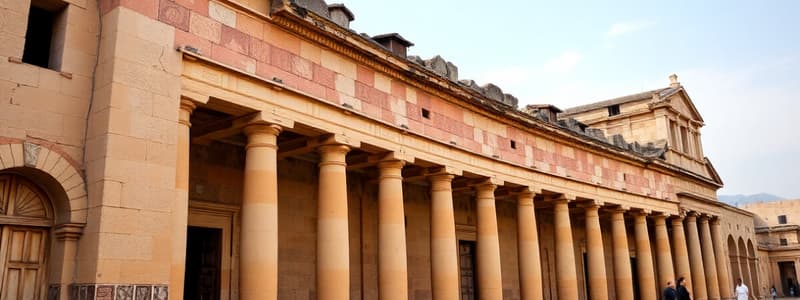Podcast
Questions and Answers
What is the focus of Theme 1: Writing and City Life?
What is the focus of Theme 1: Writing and City Life?
- Mesopotamia (correct)
- Mongol Empire
- Korean history
- Roman Empire
Which empire is the focus of Theme 2: An Empire across Three Continents?
Which empire is the focus of Theme 2: An Empire across Three Continents?
- Mesopotamian Empire
- Roman Empire (correct)
- Mongol Empire
- Korean Empire
What time period does Theme 3: Nomadic Empires primarily focus on?
What time period does Theme 3: Nomadic Empires primarily focus on?
- 6 MYA to 1 BCE
- 3rd millennium BC
- 13th to 14th century (correct)
- 1700 to 2000
Theme 7 includes the story of Korea and rapid industrialization under strong leadership.
Theme 7 includes the story of Korea and rapid industrialization under strong leadership.
What is the primary geographical focus of 'Writing and City Life'?
What is the primary geographical focus of 'Writing and City Life'?
What time frame is associated with the Roman Empire in 'An Empire across Three Continents'?
What time frame is associated with the Roman Empire in 'An Empire across Three Continents'?
Flashcards
History
History
Study of past human actions through material remains.
History
History
Texts intended to educate students.
Timeline I
Timeline I
Timeline spanning from 6 million years ago to 1 BCE.
Writing
Writing
Signup and view all the flashcards
City Life
City Life
Signup and view all the flashcards
Timeline II
Timeline II
Signup and view all the flashcards
Empire
Empire
Signup and view all the flashcards
Timeline III
Timeline III
Signup and view all the flashcards
Timeline IV
Timeline IV
Signup and view all the flashcards
Early Urban Centers
Early Urban Centers
Signup and view all the flashcards
Nature of early urban societies
Nature of early urban societies
Signup and view all the flashcards
Uses of writing
Uses of writing
Signup and view all the flashcards
World Empire
World Empire
Signup and view all the flashcards
An Empire across Three Continents
An Empire across Three Continents
Signup and view all the flashcards
Political evolution
Political evolution
Signup and view all the flashcards
Economic expansion
Economic expansion
Signup and view all the flashcards
Religion
Religion
Signup and view all the flashcards
Late Antiquity
Late Antiquity
Signup and view all the flashcards
Slavery
Slavery
Signup and view all the flashcards
Nomadic Society
Nomadic Society
Signup and view all the flashcards
Nomadic Empires
Nomadic Empires
Signup and view all the flashcards
Nature of nomadism
Nature of nomadism
Signup and view all the flashcards
Formation of empires
Formation of empires
Signup and view all the flashcards
Conquests and relations with other states
Conquests and relations with other states
Signup and view all the flashcards
Three Orders
Three Orders
Signup and view all the flashcards
Changing Cultural Traditions
Changing Cultural Traditions
Signup and view all the flashcards
Modernization
Modernization
Signup and view all the flashcards
Displacing Indigenous Peoples
Displacing Indigenous Peoples
Signup and view all the flashcards
Paths to Modernization
Paths to Modernization
Signup and view all the flashcards
Growth of towns
Growth of towns
Signup and view all the flashcards
Study Notes
- History syllabus for Higher Secondary First Year Course for 2024-2025.
- One paper, three-hour time duration, and 100 marks.
Section I: Early Societies
- 15 marks.
- Includes an introduction to Early Societies.
- Includes Timeline I, spanning from 6 MYA to 1 BCE.
- Theme 1, Writing and City Life, 23 periods.
- Focuses on Mesopotamia in the 3rd millennium BC.
- Includes the growth of towns.
- Includes the nature of early urban societies.
- Discusses the uses of writing.
- Aims to familiarize learners with the nature of early urban centers.
- Discusses whether rewriting is significant as a marker of civilization.
Section II: Empires
- 25 marks.
- Includes introduction to Empires:
- Includes Timeline II, spanning from c. 100 BCE to 1300 CE.
- Theme 2, An Empire Across Three Continents, 22 periods.
- Focuses on the Roman Empire from 27 BC to AD 600.
- Includes the political evolution, economic expansion and religion of the Roman Empire
- Discusses the institution of slavery.
- Aims to familiarize learners with the history of a major World Empire.
- Theme 3, Nomadic Empires, 22 periods.
- Focuses on the Mongol Empire in the 13th to 14th century.
- Examines the nature of nomadism.
- Examines the formation of empires.
- Includes the conquests and relations with other states.
- Discusses nomadic societies and state formation.
- Aims to familiarize learners with the varieties of nomadic society and their institutions.
- Discusses whether state formation is possible in nomadic societies.
- Aims to familiarize the learner with the history of a major World Empire.
- Discusses whether slavery was a significant element in the economy.
Section III: Changing Traditions
- 30 marks.
- Includes an introduction to Changing Traditions..
- Includes Timeline III, spanning from c. 1300 to 1700.
- Theme 4, Three Orders, 23 periods.
- Theme 5, Changing, Cultural Traditions, 20 periods.
Section IV: Towards Modernization
- 30 marks.
- Includes an introduction to Modernization..
- Includes Timeline IV, spanning from c. 1700 to 2000.
- Theme 6, Displacing Indigenous Peoples, 25 periods.
- Theme 7, Paths To Modernization, 25 periods.
- Excludes the story of Korea, rapid industrialization under strong leadership, continued economic growth and cause for democratization, Korean democracy, and the IMF Crisis.
- Total marks: 100.
- Total periods: 180.
Studying That Suits You
Use AI to generate personalized quizzes and flashcards to suit your learning preferences.
Description
History syllabus for Higher Secondary First Year Course, 2024-2025. Includes early societies with a focus on Mesopotamia, urban growth and, writing. Also covers empires like Roman Empire, political evolution and economic expansion.




